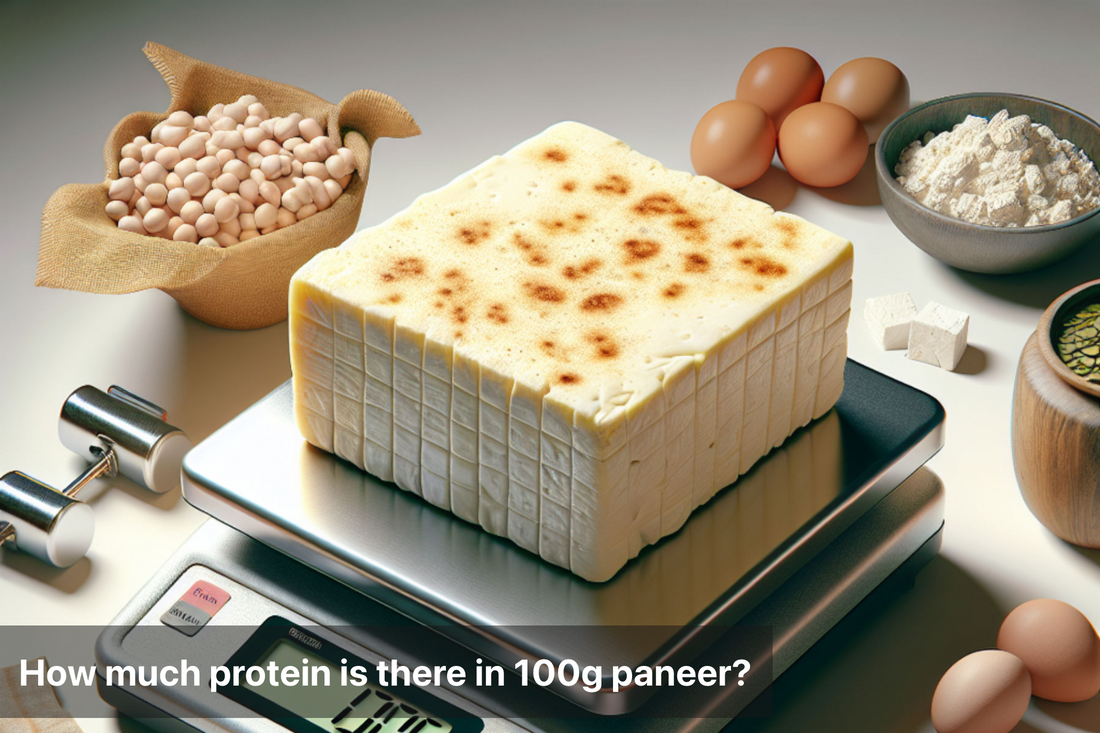
How much protein is there in 100g paneer?
Share
Paneer, also known as Indian cottage cheese, is a popular vegetarian protein source across Indian households. Whether it’s added to curries, grilled in tikkas, or stuffed into parathas, paneer is both delicious and nutrient-dense. For those tracking their macronutrients—especially protein—paneer is often considered a go-to food. But exactly how much protein is there in 100 grams of paneer? And what makes it such a valued ingredient in high-protein diets?
In this blog, we break down the protein content in paneer, its complete nutritional profile, how it compares to other proteins, and the healthiest ways to consume it.
Protein Content in 100g Paneer
On average, 100 grams of paneer contains around 18–21 grams of protein depending on how it's prepared. Homemade paneer tends to retain more moisture and has slightly less protein, while commercial paneer may be denser and yield higher protein content.
Type of Paneer |
Protein (per 100g) |
Calories |
Fat |
Carbohydrates |
|---|---|---|---|---|
Homemade Paneer |
18g |
~265 kcal |
20g |
1–2g |
Commercial Paneer (full-fat) |
20–21g |
~300 kcal |
22–25g |
2–3g |
Low-fat Paneer |
14–15g |
~180 kcal |
10–12g |
2g |
Paneer is a complete protein, containing all nine essential amino acids, making it particularly beneficial for vegetarians who might struggle to meet their protein needs from plant-based sources alone.
Why Protein Matters in a Balanced Diet
Protein is crucial for building and repairing tissues, including muscles, skin, hair, and organs. Including protein-rich foods like paneer in your daily meals can help:
Promote muscle growth and recovery
Support weight loss by increasing satiety
Stabilize blood sugar levels
Boost metabolism
Maintain healthy hair, skin, and nails
Paneer as a Vegetarian Protein Source
One of the main challenges in vegetarian diets is sourcing high-quality protein. Paneer solves this problem by offering:
High bioavailability of protein
Slow-digesting casein protein that keeps you full longer
Richness in calcium, which supports bone health
Good fat content for energy and absorption of fat-soluble vitamins
Because it’s dairy-based, paneer also contributes to your daily intake of vitamin B12, phosphorus, and magnesium.
Comparing Paneer with Other Protein-Rich Foods
Food Item (100g) |
Protein |
Calories |
Notes |
|---|---|---|---|
Paneer |
18–21g |
260–300 |
High-fat, complete dairy protein |
Tofu |
10–12g |
~140 |
Soy-based, lower in fat |
Chicken breast (cooked) |
25–30g |
~165 |
Lean meat, high in protein |
Eggs (2 large eggs) |
12g |
~140 |
Easily digestible, versatile |
Boiled Lentils |
9g |
~115 |
High in fiber, incomplete protein |
Greek Yogurt (unsweetened) |
10g |
~60–100 |
Lower in fat, probiotic benefits |
Paneer is not the leanest source of protein but is nutrient-rich and particularly suitable for vegetarian and low-carb diets.
Health Benefits of Eating Paneer
Muscle support: Helps meet protein needs for growth and repair
Weight management: High satiety helps reduce overeating
Bone health: Rich in calcium and phosphorus
Low glycemic: Suitable for diabetics in moderation
Digestive health: Contains casein which digests slowly and steadily
When Is the Best Time to Eat Paneer?
Paneer is versatile and can be consumed at various times based on your goal:
Breakfast: Include it in a stuffed paneer paratha or scrambled with vegetables for sustained energy
Lunch: Add to a salad or pair with roti and sabzi
Pre-workout: Paneer may be too heavy unless lightly grilled or eaten in small portions
Post-workout: Paneer provides casein, which is slowly digested, making it suitable for muscle recovery when combined with faster proteins
Dinner: Works well with low-carb dishes or grilled preparations to keep digestion light
Healthy Ways to Include Paneer in Your Diet
Grilled paneer tikkas: Avoids added oil, packed with flavor
Paneer bhurji: Made with minimal oil and added vegetables
Paneer salads: Tossed with greens, olive oil, and herbs
Paneer wrap: Use whole-wheat or multigrain roti with paneer and veggies
Paneer in curries: Choose tomato-based gravies over creamy, high-fat ones
Avoid deep-fried paneer starters or heavily buttered dishes if you’re watching fat and calorie intake
Is Paneer Suitable for Weight Loss?
Yes—when consumed in moderation. Although paneer is high in fat, it is also high in protein, which:
Increases satiety and reduces snacking
Supports muscle mass retention during calorie deficits
Has a thermic effect (body burns more calories digesting it)
Opt for low-fat paneer if you're strictly tracking calories, and balance it with vegetables, whole grains, or pulses to create complete meals
Who Should Moderate Paneer Intake?
Individuals with high cholesterol: Full-fat paneer contains saturated fat, which should be limited
Those with lactose intolerance: Though lower in lactose than milk, paneer may still cause digestive discomfort
People with kidney issues: High-protein diets may need adjustment based on medical advice
Always consult a healthcare provider or nutritionist for personalized guidance
Conclusion
So, how much protein is there in 100g of paneer? On average, you’ll get 18 to 21 grams of high-quality protein, along with calcium, fats, and essential vitamins. Paneer is an excellent protein source for vegetarians, offering numerous health benefits when eaten in moderation
Whether your goal is building muscle, losing weight, or simply eating balanced meals, paneer can be a delicious and effective addition to your diet. From salads and tikkas to bhurji and wraps, its versatility means you never have to compromise on flavor or nutrition.






